
This is a list of vehicles developed from the Japanese Type 97 Chi-Ha medium tank and its direct lineage.

This is a list of vehicles developed from the Japanese Type 97 Chi-Ha medium tank and its direct lineage.















The Type 97 Chi-Ha was a medium tank used by the Imperial Japanese Army during the Second Sino-Japanese War, the Battles of Khalkhin Gol against the Soviet Union, and the Second World War. It was the most widely produced Japanese medium tank of World War II.

The Type 95 Ha-Gō was a light tank used by the Empire of Japan during the Second Sino-Japanese War, at Nomonhan against the Soviet Union, and in the Second World War. It proved sufficient against infantry but was not effective against other tanks. Approximately 2,300 were produced, making it the most numerous Japanese armoured fighting vehicle of the Second World War.
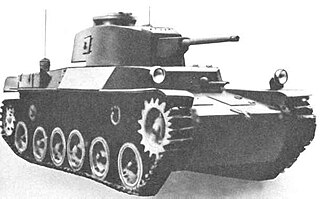
The Type 1 medium tank Chi-He was an improved version of the Type 97 Chi-Ha medium tanks of the Imperial Japanese Army in World War II. It had a more powerful main gun, engine and thicker armor. It was the first Japanese tank to have a communication radio as standard equipment. Production of the tank did not begin until 1943, due to the higher priority of steel allocated to the Imperial Navy for warship construction. A total of 170 units were built. All of the tanks produced were allocated for the defense of the Japanese home islands, against the anticipated Allied Invasion.

The Type 2 Gun tank Ho-I was a derivative of the Type 97 Chi-Ha medium tanks of the Imperial Japanese Army in World War II. Similar in concept to the early variants of the German Panzer IV, it was designed as a self-propelled howitzer to provide the close-in fire support for standard Japanese medium tanks with additional firepower against enemy anti-tank fortifications.
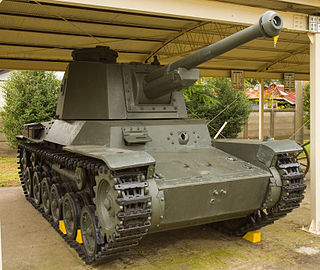
Type 3 Medium Tank Chi-Nu was a medium tank of the Imperial Japanese Army in World War II. Like the Type 1 Chi-He, this tank was an improved version of the Type 97 Chi-Ha. It incorporated a Type 3 75 mm tank gun, one of the largest Japanese tank guns during the war.
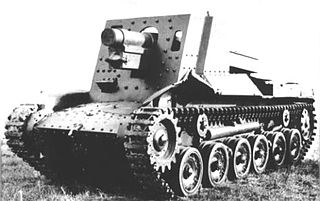
The Type 4 15cm self-propelled gun Ho-Ro was based on an already existing reinforced Type 97 Chi-Ha medium tank chassis developed by the Imperial Japanese Army in World War II.

The Special Type 3 Launch Ka-Chi was an amphibious medium tank developed by the Imperial Japanese Navy in World War II. The Type 3 Ka-Chi was based on an extensively modified Imperial Japanese Army Type 1 Chi-He medium tank and was a larger and more capable version of the earlier Type 2 Ka-Mi amphibious tank.

The Imperial Japanese Army (IJA) initially purchased foreign tanks for evaluation during World War I, and began developing its own indigenous designs during the late 1920s.

The Type 2 Ke-To was a light tank of World War II, produced in small numbers for the Imperial Japanese Army as an improvement of the existing Type 98 Ke-Ni. No Type 2 Ke-To light tanks are known to have engaged in combat prior to Japan's surrender at the end of World War II.
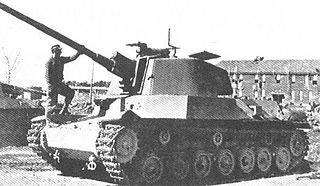
The Type 4 medium tank Chi-To was one of several medium tanks developed by the Imperial Japanese Army towards the end of World War II. While by far the most advanced Japanese wartime tank to reach production, industrial and material shortages resulted in only a few chassis being manufactured and only two known to be completed. Neither of the completed Type 4 Chi-To tanks saw combat use.

The Type 5 medium tank Chi-Ri was a medium tank developed by the Imperial Japanese Army in World War II. It was intended to be a heavier, more powerful version of Japan's prototype Type 4 Chi-To medium tank. Only one incomplete prototype was built.

The Experimental Medium Tank Chi-Ni was a prototype Japanese medium tank. Initially proposed as a low-cost alternative to the Type 97 Chi-Ha medium tank, it was eventually passed over by its competitor.

The Type 3 Gun tank Ho-Ni III was a tank destroyer and self-propelled artillery of Imperial Japanese Army in World War II. The Type 3 Ho-Ni III superseded the Type 1 Ho-Ni I and its variant the Type 1 Ho-Ni II in production, and gave better protection to the crew by having a completely enclosed superstructure. It was also meant to replace the Type 2 Ho-I for fire support.

The Type 97 Shinhōtō Chi-Ha was a Japanese medium tank used in World War II that was an upgrade to the original Type 97 Chi-Ha. The new version was designated Type 97-Kai ("improved"), Shinhōtō Chi-Ha or simply "Type 97/47". Armed with a Type 1 47 mm tank gun, this design was considered to be the best Japanese tank to have seen combat service during the Pacific War. It first saw combat service at Corregidor Island in the Philippines in 1942.
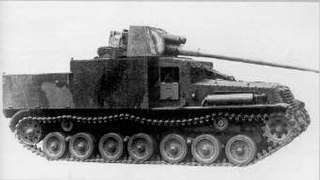
The Type 5 Na-To, officially known as the Experimental 7.5cm self-propelled anti-tank gun Na-To was the penultimate self-propelled anti-tank gun developed by the Imperial Japanese Army in 1945, during the closing stages of World War II.

The Type 1 Gun tank Ho-Ni I was a tank destroyer and self-propelled artillery developed by the Imperial Japanese Army for use during World War II in the Pacific theater. It saw limited combat action, being first deployed at the Battle of Luzon in the Philippines in 1945. There were two variant models known as the Ho-Ni II and Ho-Ni III. All three types were only produced in limited numbers.

This article deals with the history and development of tanks of the Japanese Army from their first use after World War I, into the interwar period, during World War II, the Cold War and modern era.

The experimental Type 98 Chi-Ho was a prototype Japanese medium tank. It was developed on orders from the Imperial Japanese Army. "Chi Ho" indicates that it is designated as the 5th medium (Chi) tank. A total of four prototypes were completed. Two were built in 1940 and two were built in 1941. It did not enter production.